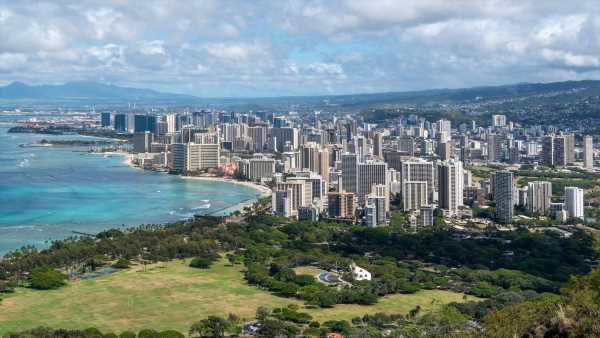
After benefiting from a boom in pent-up demand and the surge of Americans traveling domestically, Hawaii may finally be seeing a slowdown as the summer season kicks off.
Jack Richards, CEO of Pleasant Holidays, said that starting in June and continuing nearly through the end of the year, the company is seeing double-digit declines in Hawaii after a strong start to the year.
“If we go back to the first quarter of 2023, Hawaii was absolutely exceptional for everybody,” Richards said.
And while strength continued from January through April, the first sign of decline was a flat May, he said, just before the downtrend began for June.
What’s worse, Richards said, July appears to have the biggest decline, with Pleasant’s Hawaii business projected to be down around 30% that month. Moreover, when compared with 2019, Richards expects business for the year to decline or be flat, weighed down by a lackluster performance in the latter half of the year.
Hotel rates and occupancy are also sliding. According to the Hawaii Hotel Performance Report for April, published by the Hawaii Tourism Authority, hotels statewide reported weaker revenue per available room (RevPAR) and occupancy compared with April 2022, with occupancy for the month also coming in below April 2019 levels.
The report, which pulled from data compiled by STR, indicated that statewide RevPAR in April 2023 was down 2.2% and occupancy fell 2 percentage points on the same month last year, though ADR eked out a 0.5% gain.
Preliminary data from STR for the month of May, meanwhile, signaled continued softening of demand, with occupancy slipping 1.4% and RevPAR down 0.2%, even as ADR rose 1.2% on May of last year.
Strong pandemic rebound
Hawaii was among the domestic destinations where travel recovered fastest and even benefited during the pandemic. State data shows that in 2022, 1.67 million visitors traveled to Hawaii, a 94.9% recovery from 2020. Total visitor spending, meanwhile, outpaced pre-pandemic levels by 15%, reaching $2.68 billion.
Part of the current pullback may simply be attributable to a more competitive travel landscape.
“Last year, you had a lot of high-income leisure travelers who couldn’t go anywhere else,” said Isaac Collazo, STR’s vice president of analytics. “Now they’re probably going to Bora Bora, Tahiti and obviously Europe and all these other places that are open.”
Richards echoed those sentiments, declaring Europe “the clear winner” when it comes to attracting tourists this year.
“Everybody is going to Europe,” said Richards. “And the prices for a European vacation, compared to Hawaii, are almost the same.”
Indeed, Hawaii hotel prices are at an all-time high. According to STR, for the 12 months through May 2023, ADR on the Islands hit a record estimated level of $381.
“Yes, occupancy has come down, but they’re still growing rates above the rate of inflation,” said STR’s Collazo.
Angela Hughes, CEO and founder of Florida-based Trips & Ships Luxury Travel, said the sky-high cost of hotels and other travel-related expenditures in Hawaii was impacting bookings.
“The hotel prices are so high, and I think the family market is where we’re really starting to feel the crunch,” Hughes said. “But I also have high net worth individuals who are saying, ‘We’re not paying $2,000 a night for a Four Seasons in Hawaii. That’s Maldives pricing.’ And so then they start to look at international destinations.”
Hawaii is also being negatively impacted by the slower-than-expected return of the Japanese traveler, which plummeted to 199,760 visitors in 2022 compared with 1.6 million visitors in 2019, an 87.3% drop.
“Oahu, in particular, still has not recovered from the loss of the Japanese business,” Richards said. “So we are starting to see some discounting start to appear in Oahu due solely to the fact that the Japanese market isn’t back yet.”
Overall, however, Richards said he has yet to see any significant hotel discounting across Hawaii as a whole, with rates generally continuing to hover at high levels.
“I think the consensus, at least today, is that they intend to hold the rates,” he said. “And I think they know they may sacrifice some occupancy and RevPAR to do that.”
Hawaii’s Outrigger Resorts & Hotels, which has five properties on Oahu, three on Maui and one on the Big Island of Hawaii, expects to maintain 90% occupancy across its Hawaii portfolio this summer, according to CEO Jeff Wagoner.
Wagoner acknowledged, however, that the company may have to adjust rate to keep occupancy running at that threshold.
“The lever that you can pull to drive occupancy is rate,” he said. “We may have to use that lever if some of that demand is not there, but we can still run the higher occupancies and drive the business. So I feel really good about this summer.”
STR’s Collazo, meanwhile, said it may be too soon to tell whether Hawaii’s springtime occupancy declines are cause for concern or a mere blip on the recovery radar.
“Hawaii is still recovering,” he said. “You do have the domestic traveler — and especially the high-dollar domestic traveler — going elsewhere, but little by little, they’re going to get the Asian traveler back. So we’ll just have to wait and see.”
Source: Read Full Article









